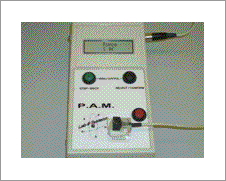Print version
Search Pub Med
A novel behavioural readout for assessing hypersensitivity of knee joints in a murine model of unilateral arthritis The aim of this study was to develop a new quantitative method for measuring hypersensitivity of the knee (stifle) joint during a murine model of unilateral arthritis (Gauldie et al,. 2004). The pressure application measurement device (PAM) is designed to objectively assess a discreet localised hypersensitivity across the knee joint. The force applied across a joint under test is measured by a force transducer fitted to the experimenter’s thumb (see Figure 1). A gradually increasing ‘squeeze’ force was applied across the joint and by means of calibrated instrumentation the force in grams applied was recorded. The test endpoint was when the animal withdrew its limb. Male C57B6 mice (n=24, 23-27g) were transiently anaesthetised (3% isofluorane with O2 at 1.5l.min-1) and a small incision was made over the knee joint to show the patella tendon, sham (n=8) animals recovered with no further treatment. The remaining 16 animals were injected with Freund’s complete adjuvant (FCA; 20μl, 10mg.ml-1) under the patella tendon into the intra-articular space of the joint. Prior to surgery and for 21 days following PAM withdrawal threshold, weight bearing (Clayton et al,. 1997), knee diameter and body weight were recorded. On day 10 the FCA injected animals were ranked and randomised into two matched groups (n=8) and dosed ( s.c.) on days 13-17 with either prednisolone (1mg.kg-1) or vehicle (ethanol 5%, PEG 45% and distilled water 50%). PAM data were transformed into an area under the curve (AUC) value and analysed using a Mann-Whitney test, where p<0.05 was considered significant. Results showed FCA injected animals had significantly lower withdrawal thresholds than sham on day 3 (p= 0.0001), when compared to day 0, confirming the FCA induced hypersensitivity. Over days 13-17 the prednisolone treated group had significantly higher AUC values than the vehicle group (p= 0.0104), compared to day 10, due to a reversal of hypersensitivity. PAM results correlated significantly with weight bearing data (r= 0.9, Pearson’s correlation). These results show that PAM is a robust tool which provides an easy to use objective method for localised assessment of knee joint hypersensitivity in mice, which correlates strongly with a previously accepted behavioural readout. Figure 1. Pressure application measurement device (PAM)
Clayton et al,. 1997 Br J Pharmacol 120:219P. |


